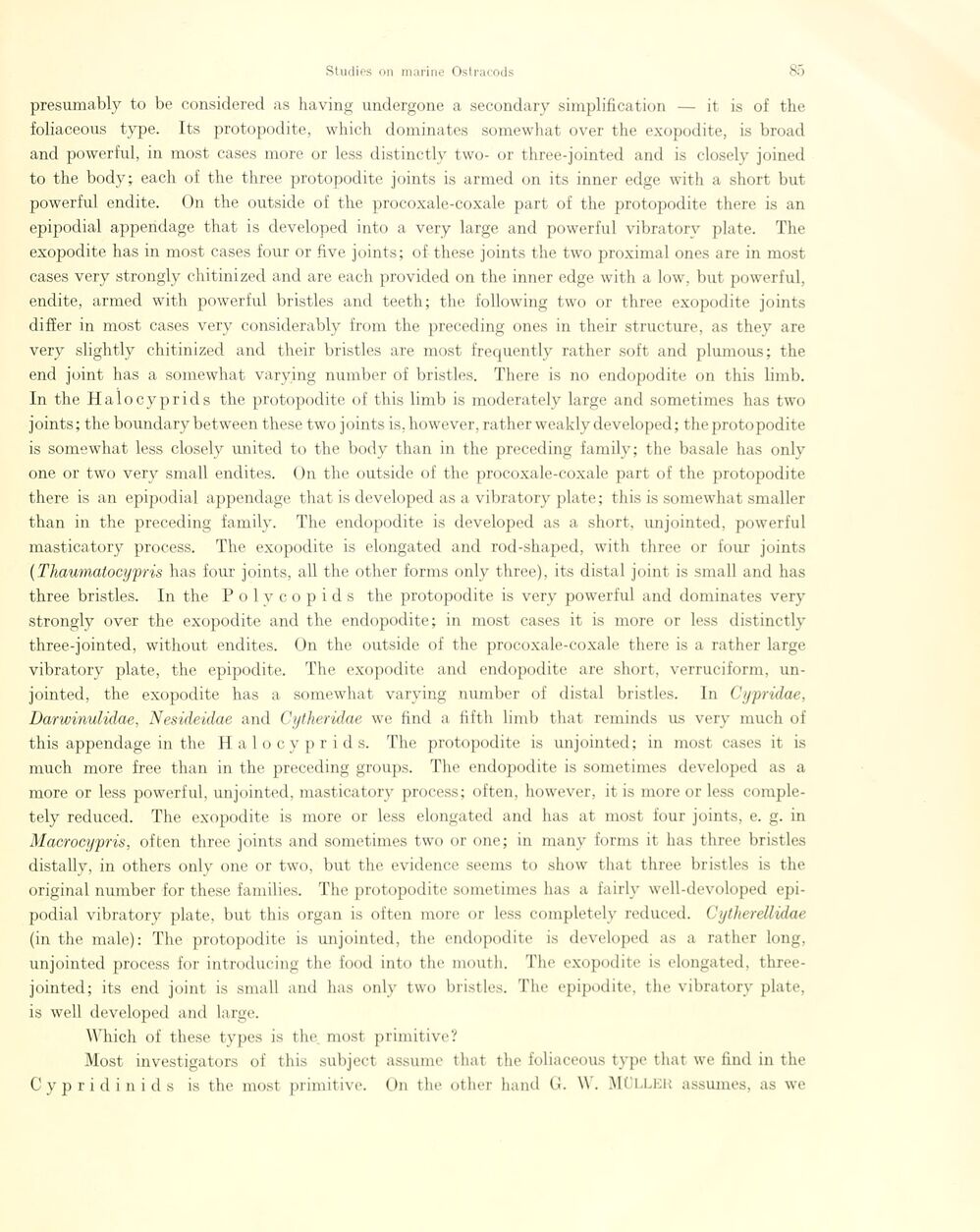
Full resolution (JPEG) - On this page / på denna sida - Sidor ...

<< prev. page << föreg. sida << >> nästa sida >> next page >>
Below is the raw OCR text
from the above scanned image.
Do you see an error? Proofread the page now!
Här nedan syns maskintolkade texten från faksimilbilden ovan.
Ser du något fel? Korrekturläs sidan nu!
This page has never been proofread. / Denna sida har aldrig korrekturlästs.
presumably to be considérée! as having undergone a secondary simplification — it is of tlie
foliaceous type. Its protopodite, which dominâtes somewhat over the exopodite, is broad
and powerful, in most cases more or less distinctly two- or three-jointed and is closely joined
to the body; each of the three protopodite joints is armed on its inner edge with a short but
powerful endite. On the outside of the procoxale-coxale part of the protopodite there is an
epipodial appendage that is developed into a very large and powerful vibratory plate. The
exopodite has in most cases four or five joints; of these joints the two proximal ones are in most
cases very strongly chitinized and are each provided on the inner edge with a low, but powerful,
endite, armed with powerful bristles and teeth; the following two or three exopodite joints
differ in most cases very considerably from the preceding ones in their structure, as they are
very slightly chitinized and their bristles are most frequently rather soft and plumous; the
end joint has a somewhat varying nurnber of bristles. There is no endopodite on this limb.
In the Halocyprids the protopodite of this limb is moderately large and sometimes has two
joints; the boundary between these two joints is,however, rather weakly developed; the protopodite
is somewhat less closely united to the body than in the preceding family; the basale has only
one or two very small endites. On the outside of the procoxale-coxale part of the protopodite
there is an epipodial appendage that is developed as a vibratory plate ; this is somewhat smaller
than in the preceding family. The endopodite is developed as a short, unjointed, powerful
masticatory process. The exopodite is elongated and rod-shaped, with three or four joints
(Thaumatocypris has four joints, all the other forms only three), its distal joint is small and has
three bristles. In the Polvcopids the protopodite is very powerful and dominâtes very
strongly over the exopodite and the endopodite; in most cases it is more or less distinctly
three-jointed, without endites. On the outside of the procoxale-coxale there is a rather large
vibratory plate, the epipodite. The exopodite and endopodite are short, verruciform,
unjointed, the exopodite has a somewhat varying nurnber of distal bristles. In Cypridae,
Darwinulidae, Nesideidae and Cytheridae we find a fifth limb that reminds us very much of
this appendage in the Halocyprids. The protopodite is unjointed; in most cases it is
much more free than in the preceding groups. The endopodite is sometimes developed as a
more or less powerful, unjointed, masticatory process; often, however, it is more or less
cornple-tely reduced. The exopodite is more or less elongated and has at most four joints, e. g. in
Macrocypris, often three joints and sometimes two or one; in many forms it has three bristles
distally, in others only one or two, but the evidence seems to show that three bristles is the
original number for these families. The protopodite sometimes has a fairly well-devoloped
epipodial vibratory plate, but this organ is often more or less completely reduced. Cytherellidae
(in the male): The protopodite is unjointed, the endopodite is developed as a rather long,
unjointed process for introducing the food into the mouth. The exopodite is elongated,
three-jointed; its end joint is small and has only two bristles. The epipodite, the vibratory plate,
is well developed and large.
Which of these types is the most primitive?
Most investigators of this subject assume that the foliaceous type that we find in the
Cypridinids is the most primitive. On the other hand G. \\. MULLER assumes, as we
<< prev. page << föreg. sida << >> nästa sida >> next page >>